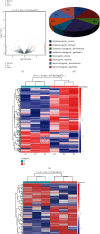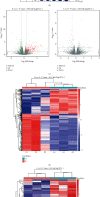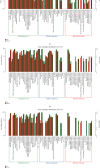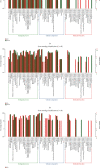Comprehensive Analysis of the Profiles of Differentially Expressed mRNAs, lncRNAs, and circRNAs in Phosgene-Induced Acute Lung Injury
- PMID: 33506021
- PMCID: PMC7811572
- DOI: 10.1155/2021/6278526
Comprehensive Analysis of the Profiles of Differentially Expressed mRNAs, lncRNAs, and circRNAs in Phosgene-Induced Acute Lung Injury
Abstract
Phosgene exposure can cause acute lung injury (ALI), for which there is no currently available effective treatment. Mesenchymal stem cells (MSCs) which have been proven to have therapeutic potential and be helpful in the treatment of various diseases, but the mechanisms underlying the function of MSCs against phosgene-induced ALI are still poorly explored. In this study, we compared the expression profiles of mRNAs, lncRNAs, and circRNAs in the lung tissues from rats of three groups-air control (group A), phosgene-exposed (group B), and phosgene + MSCs (group C). The results showed that 389 mRNAs, 198 lncRNAs, and 56 circRNAs were differently expressed between groups A and B; 130 mRNAs, 107 lncRNAs, and 35 circRNAs between groups A and C; and 41 mRNAs, 88 lncRNAs, and 18 circRNAs between groups B and C. GO and KEGG analyses indicated that the differentially expressed RNAs were mainly involved in signal transduction, immune system processes, and cancers. In addition, we used a database to predict target microRNAs (miRNAs) interacting with circRNAs and the R network software package to construct a circRNA-targeted miRNA gene network map. Our study showed new insights into changes in the RNA expression in ALI, contributing to explore the mechanisms underlying the therapeutic potential of MSCs in phosgene-induced ALI.
Copyright © 2021 Yiru Shao et al.
Conflict of interest statement
The authors declare no conflict of interest.
Figures









Similar articles
-
Whole transcriptome analysis of the differential RNA profiles and associated competing endogenous RNA networks in LPS-induced acute lung injury (ALI).PLoS One. 2021 May 7;16(5):e0251359. doi: 10.1371/journal.pone.0251359. eCollection 2021. PLoS One. 2021. PMID: 33961683 Free PMC article.
-
Overexpression of CXCR7 promotes mesenchymal stem cells to repair phosgene-induced acute lung injury in rats.Biomed Pharmacother. 2019 Jan;109:1233-1239. doi: 10.1016/j.biopha.2018.10.108. Epub 2018 Nov 7. Biomed Pharmacother. 2019. PMID: 30551373
-
Protective role of mesenchymal stem cells transfected with miRNA-378a-5p in phosgene inhalation lung injury.Biochem Biophys Res Commun. 2020 Sep 10;530(1):189-195. doi: 10.1016/j.bbrc.2020.06.112. Epub 2020 Jul 31. Biochem Biophys Res Commun. 2020. PMID: 32828284
-
Lung-derived exosomes in phosgene-induced acute lung injury regulate the functions of mesenchymal stem cells partially via miR-28-5p.Biomed Pharmacother. 2020 Jan;121:109603. doi: 10.1016/j.biopha.2019.109603. Epub 2019 Nov 8. Biomed Pharmacother. 2020. PMID: 31707339
-
Mechanism of Phosgene-Induced Acute Lung Injury and Treatment Strategy.Int J Mol Sci. 2021 Oct 10;22(20):10933. doi: 10.3390/ijms222010933. Int J Mol Sci. 2021. PMID: 34681591 Free PMC article. Review.
References
-
- Diller W. F. Pathogenesis of phosgene poisoning. Toxicology and Industrial Health. 2016;1:7–15. - PubMed
-
- van der Heijden M., van Nieuw Amerongen G. P., Chedamni S., van Hinsbergh V. W., Johan Groeneveld A. B. The angiopoietin-tie 2 system as a therapeutic target in sepsis and acute lung injury. Expert Opinion on Therapeutic Targets. 2008;13:39–53. - PubMed
MeSH terms
Substances
LinkOut - more resources
Full Text Sources
Other Literature Sources

